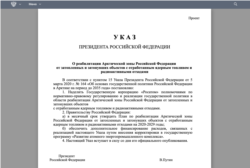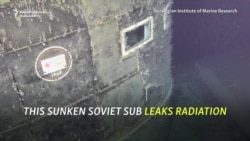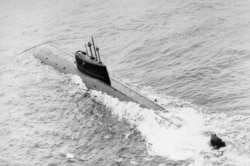The nuclear-powered submarine, built four decades earlier for the Soviet Northern Fleet, was being towed to a Murmansk shipyard to be dismantled when it was hit by a summer storm. The sub sank, killing nine sailors and sending around 800 kilograms of radioactive fuel to the sea bottom.
Since the August 2003 incident, K-159’s snapped hull has been resting around 250 meters underwater at the entrance to the Kola Bay. So far, the fuel on board has not leaked into the surrounding waters, scientists say.
The K-159 is far from the only radioactive item in the junkyard of debris that was dumped in the Barents and Kara seas over decades by the Soviet Navy. An estimated 17,000 objects are scattered across thousands of square miles, including 18 nuclear reactors and another entire nuclear sub that was scuttled off Novaya Zemlya in 1982.
For years, the Russian government, prodded by Norway, Sweden, and other nations, has struggled to figure out what to do with the waste.
Now, according to a government decree published in March, that process is at last moving forward.
The decree -- titled On The Rehabilitation Of The Russian Arctic From Flooded And Sunken Objects With Spent Nuclear Fuel And Radioactive Waste -- orders the state-run atomic energy company Rosatom to oversee the cleanup of the most dangerous objects over a nine-year-period, up to 2029.
Rosatom, which oversees Russia’s sprawling nuclear complex including reactors, enrichment, fuel production, and other operations, declined to answer inquiries from RFE/RL to provide details or comment on the effort.
But Norwegian, Swedish, and Russian experts who have followed, or been involved directly with, the effort say the March decree is a concrete step forward for cleaning up some of the most dangerous debris.
"You are quite right that our government and the Rosatom Corporation are definitely moving in this direction," said Pavel Yakovlev, who edits a Russian government-funded web portal called Nuclear Submarine Decommissioning. "The Russian government is well on its way into doing the preparatory work for formalizing the final project."
"This is an important first step for the Russian side to be able to perform practical work to reduce risks from potential radioactive contamination of the marine environment," said Ingar Amundsen of the Norwegian Radiation and Nuclear Safety Authority.
The scope of the problem, and the potential hazards to the fragile Arctic ecosystems of the Barents and Kara seas, have been studied for years by both Russian and Western scientists. A 1993 report issued by a special commission set up by President Boris Yeltsin documented three decades of toxic waste dumping, mainly in the waters near Novaya Zemlya.
"It is obvious now that there is a critical situation," the so-called Yablokov Commission said at the time in a landmark report. The International Atomic Energy Agency (IAEA) later estimated that Soviet dumping was more than double the total amount dumped by a dozen nuclear nations combined between 1946 and 1982, including the United States.
No Dumping
The IAEA banned countries from dumping high-level radioactive waste in the oceans in the 1950s. In 1983, the London Dumping Convention, whose members included the Soviet Union, the United States, and other nuclear nations, agreed to halt low-level radioactive waste dumping.
Still, Moscow for years maintained that it did not sink hazardous atomic waste, something that ultimately was refuted, and documented in full, by the Yablokov Commission.
Since then, Norway and other countries have conducted joint expeditions with Russian scientists over many years to map and measures the worst locations, and to come up with long-term plans for either cleaning them up or minimizing the danger.
At least six sunken objects, including K-159, are considered priorities for the first phase. Those objects are estimated to hold more than 90 percent of all the identified man-made radioactive waste, according to the Norwegian environment group Bellona, which has monitored Russian Arctic environmental problems for years and first highlighted the significance of the new Russian government decrees.
Scientists have warned that although little to no environmental contamination from the K-159 has been recorded to date, the sub and its reactor are in danger of decay, which would release radiation into the Kola Bay, a major waterway that is home to the port of Murmansk, about 70 kilometers south of the wreckage site.
Another nuclear-powered submarine, called the K-27, was decommissioned by the Soviet Navy in 1982 and sunk in about 100 meters of water off the eastern shore of Novaya Zemlya. Yet another site includes spent fuel from the Lenin nuclear-powered icebreaker.
The government decree does not specify what it will cost to raise or clean up the most problematic waste, nor does it answer the question of liability or responsibility for the actual process.
At a conference in Moscow in December attended by Western and Russian scientists, experts estimated that the overall cost for raising the six wrecks at 287 million euros. ($305 million).
Some experts warn that lifting some of the materials, including the broken submarine hulls or damaged nuclear reactors, will be exceedingly complex -- and risks releasing more radiation into the environment.
"It is a risk of release of radionuclides if an accident occurs during a raising operation. Therefore, it is important to perform risk assessment to minimize this risk," Amundsen told RFE/RL.
"Obviously, there is no good solution," said Rashid Alimov, director of the energy program at Greenpeace Russia in Moscow. "It is dangerous to pick up objects flooded in the seas that contain spent nuclear fuel and radioactive waste. But you can’t leave it at the bottom."
Norwegian scientists last year announced that another Soviet submarine, the K-278, or Komsomolets, which accidentally sank in April 1989 about 350 kilometers northwest of the Norwegian coast, has been leaking radiation into the surrounding waters. That wreck does not appear in the planning documents that were presented at the December conference in Moscow and were published online.
Arctic Strategy
The Russian government’s decision to move forward on a cleanup plan dovetails with a broader Arctic strategy that the Kremlin has developed in recent years. Global warming has resulted in receding sea ice, making Russia’s Arctic coast more accessible for navigation and exploration of natural resources.
Cleaning up the most problematic debris fits into that strategy, said Jonas Kjellen, a military analyst at the Swedish Defense Research Agency.
"These type of operations give Russia another purpose in the region that is not purely military (or geopolitical)," he said in an e-mail to RFE/RL.
"The story to be told is that Russia is not only in control of the Northern Sea Route and a large chunk of the Arctic, it is also a responsible shepherd of the high north," he said. "Polls also show that the Russian public is also getting evermore concerned about environmental issues, and these types of operations give the [Defense Ministry] more legitimacy and popularity."
Sunken objects are also a danger to navigation and undersea exploration, further reasons for the government’s decision to move forward, Kjellen said.
The K-159, which sank in the Kola Bay inlet, is "probably a major concern and obstacle for naval operations, and possibly also obstructs laying of submarine cables or submarine sensor systems in this important area," he said.
Still, environmental groups like Greenpeace are skeptical about the government plans, given the secrecy and obfuscation around past incidents that Rosatom was involved in. That includes last year’s explosion at a White Sea missile test base that spewed radioactive material across a nearby city, and a 2017 incident at the long-troubled Mayak nuclear complex in the southern Ural Mountains, which sent a cloud of radioactive isotopes drifting over Europe.
Both cases were marked by intense official secrecy and shifting government explanations.
Previous, more localized Russian cleanup efforts in two bays on the Kola Peninsula have already led to decreased radiation there, said Anders Turesson, who heads a working group focused on environmental issues at the Arctic Council, an eight-nation intergovernmental group based in Norway.
“We hope to see the same in the Barents and Kara seas now that Russia has decided to move forward with cleanup,” he said in a statement.














